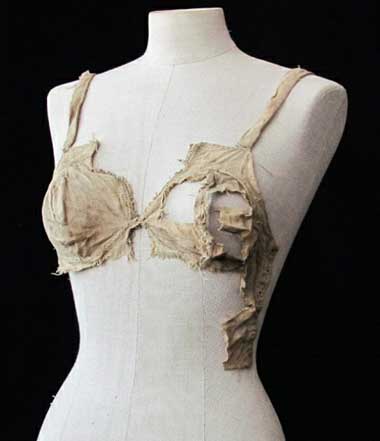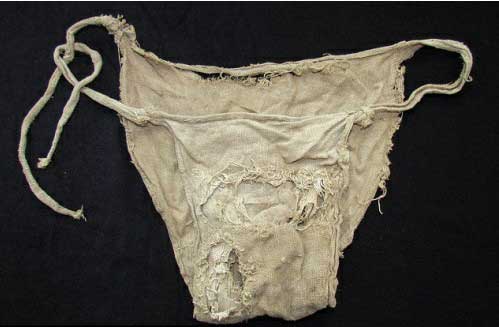當(dāng)前位置: Language Tips> 雙語新聞
分享到
 |
|
Foundations of history: This bra was discovered hidden in a vault at Lengberg Castle in East Tyrol and is thought to date back to the 15th century. |
 |
|
Revealing relic: A pair of knickers found in Lengberg Castle |
|
It is hardly racy by today’s standards but this skimpy lingerie has certainly shocked historians. The lace and linen undergarments date back to hundreds of years before women’s underwear was thought to exist. They had lain hidden in a vault beneath the floorboards of an Austrian castle since the 15th century. Despite their state of decay, the knickers bear more than a passing resemblance to the string bikini briefs popular today, while the bra has the fitted cups and delicate straps of its modern-day counterparts. While it was known that medieval men wore undergarments like modern-day shorts, it was thought that their womenfolk simply wore a smock or chemise, and that knickers didn’t make an appearance until the late 18th century. Bras were thought to be an even more modern invention, not appearing until around 100 years ago. However, Hilary Davidson, fashion curator at the Museum of London, said the discovery ‘totally rewrites’ fashion history, adding: ‘Nothing like this has ever come up before.’ She believes it is ‘entirely probable’ that something similar was worn by Britain’s medieval women. She said: ‘These finds are a very exciting insight into the way people dressed in the Middle Ages. The undergarments were among almost 3,000 fragments of clothing and other detritus found in Lengberg Castle in East Tyrol during recent renovations. It is thought that they were buried when the building was extended in 1480 and that the exceptionally dry conditions stopped the fragile garments from disintegrating over the centuries. (Read by Brian Salter. Brian Salter is a journalist at the China Daily Website.) (Agencies) |
雖然根據(jù)現(xiàn)代標(biāo)準(zhǔn),這些小而暴露的內(nèi)衣很難讓人眼前一亮,但它足以令歷史學(xué)家驚訝。 這些帶有花邊的亞麻內(nèi)衣使之前人們認(rèn)為的內(nèi)衣存在年代提早了數(shù)百年。 這些內(nèi)衣是15世紀(jì)的產(chǎn)物,人們在奧地利一座古堡的地下室里發(fā)現(xiàn)了它們。 盡管有些腐爛,但發(fā)掘出的女性內(nèi)褲和如今流行的捆帶式比基尼泳裝褲非常相似,而胸罩也和現(xiàn)代類似,有合身的罩杯和精致的肩帶。 此前人們認(rèn)為,在中世紀(jì)歐洲,男性所穿的內(nèi)衣近似于現(xiàn)代款式,而女性則穿罩衫或?qū)捤傻囊路缘陌攵虄?nèi)褲是18世紀(jì)后期的產(chǎn)物。 而胸罩則被認(rèn)為是更接近現(xiàn)代的產(chǎn)物,直到大約100年前才出現(xiàn)。 倫敦博物館的時裝館長希拉里-戴維森表示,這次發(fā)現(xiàn)“完全改寫了”時裝史,補充說:“以前從沒有過類似發(fā)現(xiàn)。” 她相信英國中世紀(jì)的女性“完全有可能”穿類似的內(nèi)衣。 她說:“這些發(fā)現(xiàn)真讓人興奮,讓我們了解到了中世紀(jì)人們的穿衣方式。” 據(jù)悉,這些內(nèi)衣是人們最近在對奧地利東提洛爾的倫貝格古堡進(jìn)行翻修時,與其它3000件衣物以及一些遺跡一并被發(fā)現(xiàn)的。 據(jù)稱,1480年古堡擴建時把這些衣物埋在了下面,異常干燥的環(huán)境使并不結(jié)實的內(nèi)衣在幾百年時間里沒有腐壞。 相關(guān)閱讀 (中國日報網(wǎng)英語點津 Julie 編輯:陳丹妮) |
|
Vocabulary: skimpy: (衣服)小而暴露的 |
上一篇 : 智商測試女性百年來首超男性
下一篇 : 日本出售全球最貴單臥公寓 售價18億日元
分享到
關(guān)注和訂閱


翻譯
關(guān)于我們 | 聯(lián)系方式 | 招聘信息
電話:8610-84883645
傳真:8610-84883500
Email: languagetips@chinadaily.com.cn